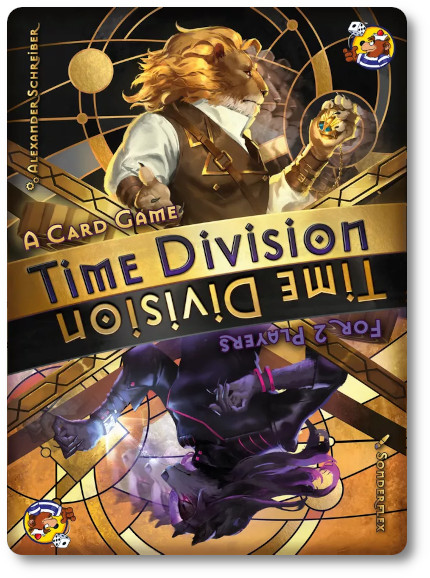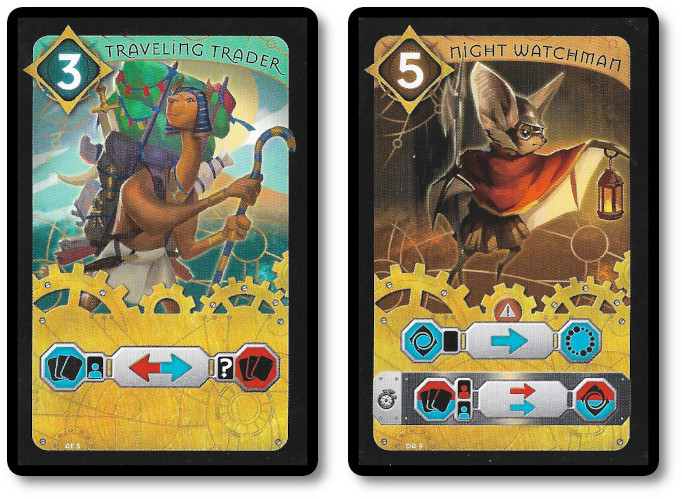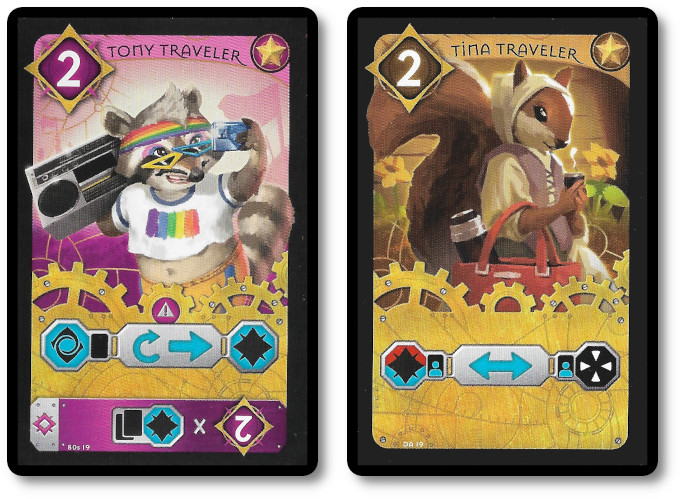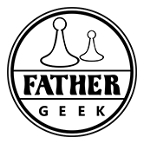 The Basics:
The Basics:
- For ages 12 and up
- For 2 players
- Approximately 60 minutes to complete
Geek Skills:
- Active Listening & Communication
- Counting & Math
- Logical & Critical Decision Making
- Reading
- Strategy & Tactics
- Hand/Resource Management
Learning Curve:
- Child – Moderate
- Adult – Moderate
Theme & Narrative:
- Travel through and protect time from your rival faction’s shenanigans
Endorsements:
- Child Geek rejected!
- Parent Geek rejected!
- Gamer Geek rejected!
Overview
The concept of a multiverse has been explored and discussed by fiction writers and scientists. The idea that there are infinite possibilities all unfolding simultaneously is both fascinating and bewildering. In this game, two different universes with their timelines have merged into one. The new combined universe is self-correcting by eliminating redundancies and duplicates to stabilize itself. Those who are aware of this now race to save their original timeline and thwart others from attempting to do the same. This game is a race against and for time.
Time Division, designed by Alexander Schreiber and published by HeidelBÄR Games, is comprised of one game board, two card platforms, one VP standee, 60 Character cards, one metal coin, and one overview sheet. The game component quality is excellent, with thick cardboard and durable cards. Illustrations by bimawithpencil are colorful and delightful, providing eye-catching characters that further reinforce the game’s theme and narrative.
Winding the Universal Watch
To set up Time Division, follow these steps.
First, set the board on the gaming table and have each player sit on opposite sides of it. Position the card platforms so each player sees the “blue” color closest to them and the “red” color on the opposite side of the game board. These colors are meant to help the players remember where the actions originate and their impact.
Second, decide which of the three Eras to play. The three include Ancient Egypt, the Dark Ages, and the 1980s. These three Eras all play slightly differently, with Ancient Egypt being the suggested beginner’s Era to explore before moving through time. Once the Era has been decided, separate it from the other cards and return the two “Time Travelers” back to the game box (these cards are used when playing the campaign). This will leave a total of 18 cards to play. Shuffle these cards and deal nine face-down to each of the “Temporary Spaces” on the game board.

Third, toss the metal coin to determine which player will go first. Place the coin in the “Coin Space” closest to the first player.
This completes the game setup. Time to travel!
Tick Tick Tick Goes Reality
Time Division is played in two phases, with several rounds in the second phase. The phases are summarized here.
Phase One: Draft
Both players simultaneously draw three cards from the Temporary Space closest to them on the game board. From these three cards, the players now complete the following until all three cards are distributed.
- Keep one card and place it face down in front of the player who owns it.
- Give one card and place it face down in front of the player’s opponent.
- Place one card face down on the “Independent Stack” space on the game board.
Once players have completed distributing the three cards, they draw another three and repeat the process until all 18 cards are distributed.
Cards kept by the player and given to them by their opponent will be added to their hand. Players cannot look at any of the cards until all have been distributed.
Phase Two: Play
Step One: The player with the metal coin is the starter. They place one card from their hand face-up in their Decision space. After the card is played, the opponent selects one card and plays it face-up to their Decision space, as well.
Step Two: The “Influence Value” is now compared between the two cards. The player who has the higher Influence Value moves the metal coin towards them. If there is a tie, the metal coin remains in its current position.
Step Three: The player in possession of the metal coin now decides what happens to each of the cards. There are only two options (Trigger or Collect), and each option can only be used once.
- Trigger one card’s ability, resolving it thoroughly by its owner, and then move the card to the “Past” area of the game board.
- Collect one card and move it to its owner’s Influence Area. Cards placed here will count towards victory points at the end of the game.
Triggering card abilities is where the real depth of the game lies. Each card has a unique ability. Abilities include, but are not at all limited to, taking cards from an opponent, moving cards to different spaces and areas, and trading cards. In short, players need not be satisfied with the placement of their cards during the game. A lot of card manipulation is possible, but it always comes at a cost, as triggered cards will not provide any victory points.
Step Four: Repeat steps one, two, and three until all the cards have been played. The Era now comes to an end.
Ending the Era and Scoring
After all the cards are played (no more cards in the players’ hands), each player adds up the Influence Values of the cards contained in their Influence Area. The player with the most influence wins the game. If there is a tie, the player who currently controls the metal coin wins the game.
Game Variant
The game comes with rules for a “campaign” game, which utilizes all three Eras. All three Eras play slightly differently in terms of cost and influence, providing players with a bit of variety each time they choose an Era. The campaign requires the players to navigate all three Eras, one after the other, and then determine the winner after all three Eras have been scored. Time Travelers are also introduced in the campaign, providing players with more options and potential victory points.

To learn more about Time Division, visit the game’s webpage.
Final Word
 The Child Geeks had a huge learning curve on this game, but not because the game was complicated. In truth, the game is very straightforward. What made the game complicated was the use of icons to represent everything in the game short of numbers. While this approach makes it very easy for the publisher to release the game in different languages, it does require the players to be knowledgeable about what the icons represent and how they are used to communicate action. This can be easily done if you continuously refer to the rulebook. The Child Geeks did this, of course, but in the process, they quickly became frustrated. As frustration grew, patience began to wane. According to one Child Geek, “I really like the artwork and I think the game sounds like a lot of fun, but it was hard to remember what everything on the cards meant and I had a few arguments about how the card icons were read. I want to like the game, but didn’t.” Another Child Geek reported, “I like the idea, but I didn’t like how much work it took to understand what the cards would do.” The end result was that all the Child Geeks wanted the time they spent with the game back.
The Child Geeks had a huge learning curve on this game, but not because the game was complicated. In truth, the game is very straightforward. What made the game complicated was the use of icons to represent everything in the game short of numbers. While this approach makes it very easy for the publisher to release the game in different languages, it does require the players to be knowledgeable about what the icons represent and how they are used to communicate action. This can be easily done if you continuously refer to the rulebook. The Child Geeks did this, of course, but in the process, they quickly became frustrated. As frustration grew, patience began to wane. According to one Child Geek, “I really like the artwork and I think the game sounds like a lot of fun, but it was hard to remember what everything on the cards meant and I had a few arguments about how the card icons were read. I want to like the game, but didn’t.” Another Child Geek reported, “I like the idea, but I didn’t like how much work it took to understand what the cards would do.” The end result was that all the Child Geeks wanted the time they spent with the game back.
 The Parent Geeks had a much easier time recognizing and remembering icons and their actions, much faster than the Child Geeks. There was still a great deal of referring to the rulebook, but the games were smoother and quicker. According to one Parent Geek, “The game is pretty smooth and easy to understand as far as how the phases are played. The most difficult part of the game was getting used to the icons. Once you understand them, however, the game goes really fast. Our first two games were an exercise in continuously referencing the rules, but by the time we played our third game, we had it down, and the game was a good time.” Another Parent Geek said, “A decent game, but not one I’d play a lot or want to teach. There were too many icons that didn’t make sense, and I had to look up their meanings in the rulebook frequently. I felt like I spent more time with the rulebook than my opponent.” When all the time travelers returned, they took a vote, but the results showed the Parent Geeks had no love for the icons.
The Parent Geeks had a much easier time recognizing and remembering icons and their actions, much faster than the Child Geeks. There was still a great deal of referring to the rulebook, but the games were smoother and quicker. According to one Parent Geek, “The game is pretty smooth and easy to understand as far as how the phases are played. The most difficult part of the game was getting used to the icons. Once you understand them, however, the game goes really fast. Our first two games were an exercise in continuously referencing the rules, but by the time we played our third game, we had it down, and the game was a good time.” Another Parent Geek said, “A decent game, but not one I’d play a lot or want to teach. There were too many icons that didn’t make sense, and I had to look up their meanings in the rulebook frequently. I felt like I spent more time with the rulebook than my opponent.” When all the time travelers returned, they took a vote, but the results showed the Parent Geeks had no love for the icons.
 The Gamer Geeks were pretty much fully aligned with the Parent Geeks on this one. Again, it came down to the iconography. One Gamer Geek put it perfectly when they reported, “This is an excellent game, with clever plays, and interesting decision making that you will never get to because the icons keep getting in the way.” Another Gamer Geek stated, “Here’s the deal with this game. It features numerous clever ideas, some tough choices to make, interesting timing decisions to consider, and strategic card shifts to alter outcomes. The problem is that none of what I just stated is even remotely obvious. The icons used in the game are difficult to understand without constant reference to the rulebook to determine the card’s actual function. This means a single card, which should be obvious at a glance, is anything but obvious, forcing the player to refer to the rulebook – again – to understand what they had to do.” When it was time to put the game away, the players took a vote and all decided that the game, with its heavy use of icons, was just too esoteric to be of value.
The Gamer Geeks were pretty much fully aligned with the Parent Geeks on this one. Again, it came down to the iconography. One Gamer Geek put it perfectly when they reported, “This is an excellent game, with clever plays, and interesting decision making that you will never get to because the icons keep getting in the way.” Another Gamer Geek stated, “Here’s the deal with this game. It features numerous clever ideas, some tough choices to make, interesting timing decisions to consider, and strategic card shifts to alter outcomes. The problem is that none of what I just stated is even remotely obvious. The icons used in the game are difficult to understand without constant reference to the rulebook to determine the card’s actual function. This means a single card, which should be obvious at a glance, is anything but obvious, forcing the player to refer to the rulebook – again – to understand what they had to do.” When it was time to put the game away, the players took a vote and all decided that the game, with its heavy use of icons, was just too esoteric to be of value.
 Personally, I’m greatly saddened by my experience with Time Division. This game has real potential to be a solid and highly entertaining two-player game. However, I didn’t once see anything other than the potential, as our players (and I) continuously needed to refer to the rulebook to not only determine what the cards did, but also to ensure that our opponent’s interpretation of the icons was accurate. This continual need to consult the rules to decode the icons for each card, every time, grew tiresome quickly. After four games, I am still consulting the rule book, but not as frequently. Proof you can learn the iconography, but only after a much more extended time than any of our players, including myself, found to be reasonable.
Personally, I’m greatly saddened by my experience with Time Division. This game has real potential to be a solid and highly entertaining two-player game. However, I didn’t once see anything other than the potential, as our players (and I) continuously needed to refer to the rulebook to not only determine what the cards did, but also to ensure that our opponent’s interpretation of the icons was accurate. This continual need to consult the rules to decode the icons for each card, every time, grew tiresome quickly. After four games, I am still consulting the rule book, but not as frequently. Proof you can learn the iconography, but only after a much more extended time than any of our players, including myself, found to be reasonable.
Which is a real shame, because I think there is an exceptional game to be found here, but only for those who are willing to take the time to learn the game’s language. Is it worth it? Our groups didn’t think so, but that is simply an opinion. I encourage you to give the game a try at your gaming table to see if you can read the icons and discover a game of actual value, or maybe not. This game will test your patience.
This game was given to Father Geek as a review copy. Father Geek was not paid, bribed, wined, dined, or threatened in vain hopes of influencing this review. Such is the statuesque and legendary integrity of Father Geek.



